Probably anyone at the start of their carrier wishes to become a manager. However, only managers and team leaders understand how hard it is to be responsible for a team’s success. You need to keep your team on track, constantly motivate them, encourage them to communicate, and follow up with them.
You need to connect the efforts of team members and combine their work to get the final result. The bigger the team, the more complicated it gets, considering that you have your own tasks and responsibilities.
Using a collaboration solution has many benefits for managers. It increases productivity, reduces admin work, fosters communication, and saves resources. The use of Microsoft Teams in particular offers many other benefits to managers. They can rely on Microsoft Teams to:
- supervise the work,
- follow up with everyone,
- keep track of the time and performance,
- preserve a healthy work environment,
- establish an efficient level of communication with everyone working in their teams, and much more.
In this article, we want to share with you some helpful tips on how you can more efficiently manage a team in Microsoft Teams.
Teams and channels to manage a team in Microsoft Teams
Integrating Microsoft Teams enables you to constantly have a general overview of your teams and their activities. By using the platform, you can divide the teams you manage into separate groups based on different criteria. Such flexibility makes it a suitable solution for various businesses and different managers. Every team leader has a unique way of managing his or her teams.
While some managers divide their teams based on responsibilities, like the initial activity team, the follow-up team, the deal closure team, the after-sales team. Others have a different approach and would divide the team based on projects or by department.
It’s a matter of what kinds of teams you manage or how you structure the workflow in your company. For instance, suppose you are a Digital Marketing Team Lead in an agency that manages the following teams:
- Social media marketing
- Content writers
- SEO specialists
- PPC advertising
- Graphic and UI/UX design
In this case, your teams can be either based on the departments/teams mentioned. Within each team then you create separate channels for more focused discussion.
| Team | Channels |
| Social media marketing | Facebook and Instagram |
| LinkedIn and Twitter | |
| Advertising budget | |
| Analytics | |
| Reports | |
| Brainstorming | |
| SEO | On-site optimization |
| Off-site optimization | |
| Backlinks | |
| Analytics | |
| Reports |
Or if you decide to create teams based on clients or their projects then the teams above can become your channels.
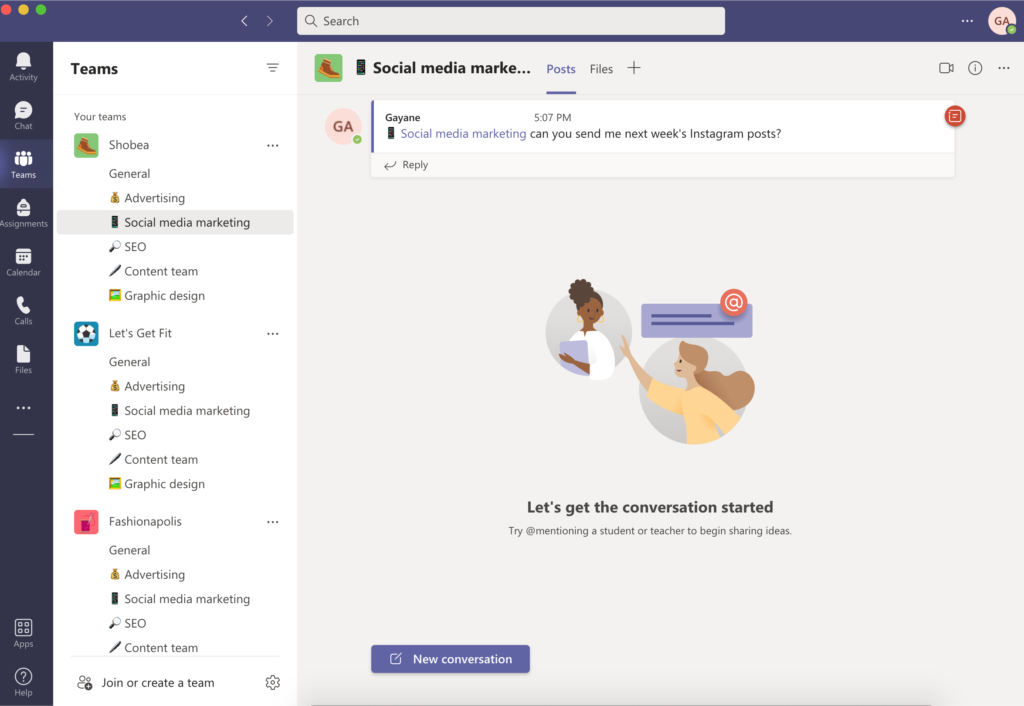
To sum up, the teams and channels that you need to have on Microsoft Teams depends entirely on how your company is structured. The ones above are recommendations that you can take and move forward with.
A dedicated onboarding team
In addition to the ones you create, we also recommend having onboarding teams that will be dedicated to new hires. You could start a new team for each new hire, then invite the direct manager and the HR supervisor. Both will be able to communicate with the new hire easily, follow up with the onboarding process step-by-step, share files, request some personal documents, and save in drive, specify details, prepare the new employee for the next level of work, and keep it all archived in that employee’s channel for a future reference. We will talk about channels in more detail soon.
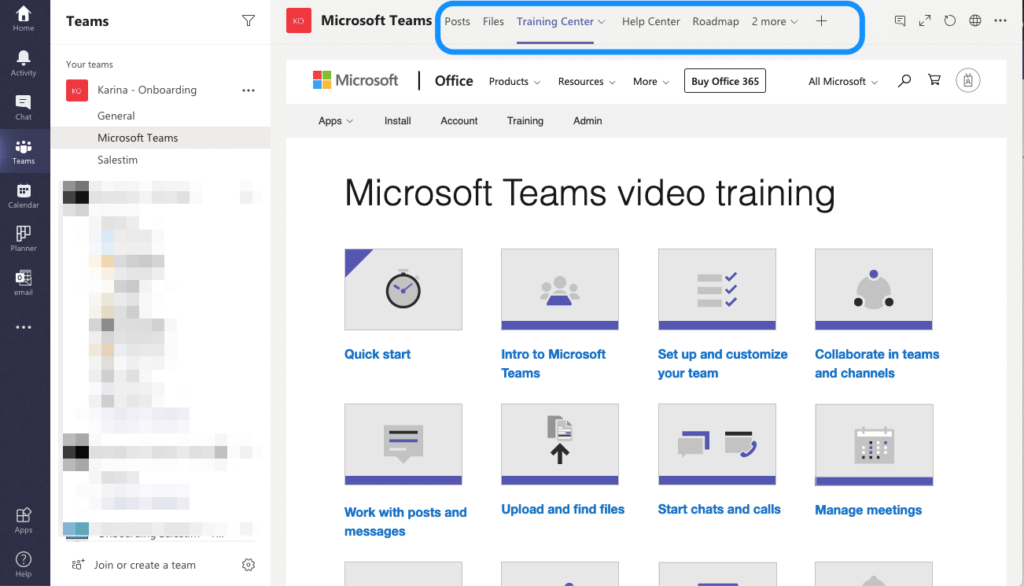
If you’re interested, there is a separate article on how to onboard new employees with Microsoft Teams.
We also want to share with you a tip by Libby Fisette from Core BTS. In her team in Microsoft Teams, she has a private channel called Leadership channel, where she keeps notes about employees. For example, details about their personal lives, professional goals that help her guide some of their career goals. She also uses the Files tab in the channel to store any draft copies of merit increases or any promotion materials.
Such channels are a great idea, especially in the onboarding team when the employees are new and you’re starting to get to know them.
How to manage a team in Microsoft Teams?
Management has unlimited approaches, and it depends on the managers themselves, the team, and the type of work they do. There are, however, basic guidelines and management models that you can apply and tools that you can use. In this section, we want to discuss some specific things that you can do to effectively manage a team in Microsoft Teams.
Create spaces for focused discussions
A big task that managers have is promoting efficient discussions. In Microsoft Teams, you do this through channel conversation. We already briefly talked about channels but when it comes to managing a team on Microsoft Teams, the channels can make it or break it.
Channels is where the actual work takes place, so you need to make sure that all your teams and sub-teams have dedicated channels. You don’t want to overdo it or have too few channels. The correct number relates to the project type and how you want to manage your team to get it completed.
So, how do you maintain the balance?
Keep in mind that channels represent a specific topic, department, or a project a team is working on, depending on the type of team you have. So, when creating channels, you need to answer this question:
What are the major areas of work that this team does?
Or if you’re creating teams based on clients, projects or stages of work, then the questions is
What are the major areas of work related to this client/project/stage?
The answers then become your channels. When you have that list, as a second step you should understand which channels should be private and public. Think about what kind of information is exchanged in these channels and you’ll have the answer for that too. For instance, the Leadership channel that we mentioned, where you keep information about your employees has to be private – this way, the new hire won’t be able to access it.
If you want to learn more about channels, make sure to read this article.
Encourage your team to maintain a work-life balance
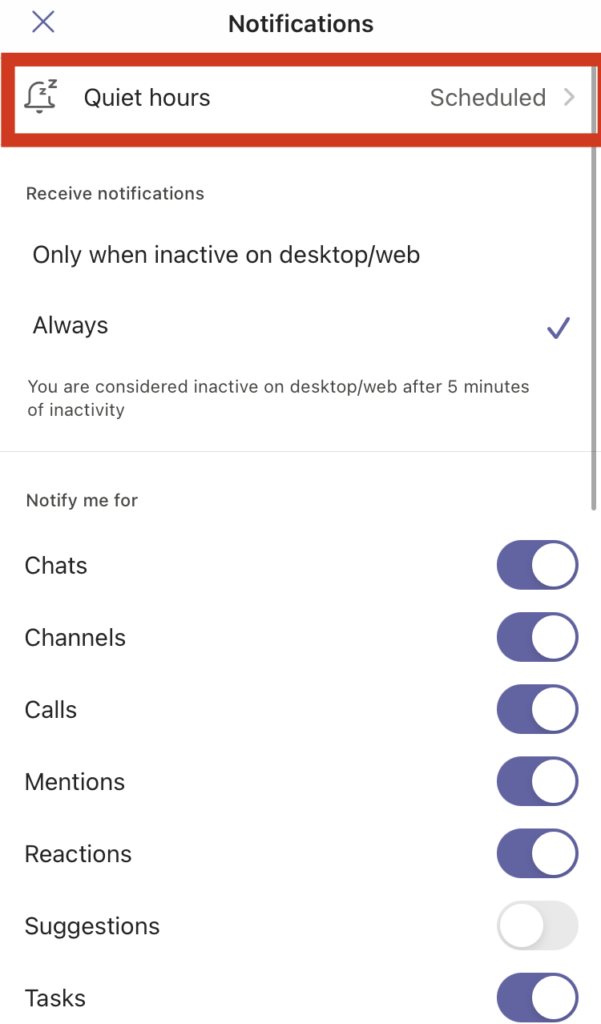
Technology has become a vital part of our lives. So, oftentimes when we turn off our laptops, we turn to our mobile phones that keep us connected with everyone. Most of us are logged into our work emails and any other apps that we use on our phones. In this sense, hybrid, asynchronous and remote teams sometimes turn into a frustrating and exhausting process, as employees keep getting notifications, emails, calls, and messages outside their working hours. Not being able to disconnect can be damaging and has many harmful effects on productivity and efficiency.
If Microsoft Teams is your collaboration tool, you can address this issue by encouraging your employees to manage their notifications. And you yourself should do the same. You and your team members can configure the notification settings based on your preferences both on the desktop version and the mobile app. For example, by default Microsoft Teams sends emails about missed activities once every hour. This can quickly fill up the inbox and be overwhelming, so you have the choice to make it daily or turn it off altogether.
Explore what else you can do with notifications here.
Here are some other ways you can promote work-life balance with Teams
@mentions
Managers tend to share critical updates about tasks, and send public announcements to everyone on the team on a daily basis. But sometimes, these messages concern only a few and not everyone. In such cases in order not to bother and interrupt everyone else’s works, use tags. With a simple @, you can mention specific people in conversations. This way, only targeted employees will be notified.
Focus time

Plus, you can encourage your team members to adjust their calendars to define focus hours. This is when they are occupied with a task and shouldn’t be disturbed unless it’s an emergency. All of you should also consider defining quiet days or hours when you are not working at all. It helps not get overwhelmed by tons of messages even on a Saturday night and helps your team avoid being distracted.
These may seem like basic things, but they will be transformative! By applying these tips into your management, you can ensure that your team feels comfortable at work without having issues of losing personal life for the sake of work.
Wellbeing insights
Viva Insight is a great app offered by Microsoft Teams to help you improve your work habits and balance your personal life with your work. It analyzes many factors of your Microsoft Teams experience and comes up with personal recommendations to enhance the quality of your work-life balance.

Meetings
No manager can ever escape meetings and let’s just accept it, meetings can be overwhelming. From setting up to facilitating and following up, it requires quite a lot of energy. Setting up meetings is time-consuming if it requires a lot of attendants. Even if you have an assistant, you still have to determine many issues, like deciding on the proper people to be invited, being on time, and getting others to attend as scheduled. These minutes turn to hours every week.
With Microsoft Teams, you can efficiently arrange meetings with your team members or external users. Everything that you need for a meeting from a tool to decide on time, to calendar invites and the actual conferencing tool are all in one place:
- Using the Forms app, you sent a survey to the channel to decide on a date and time for the meeting.
- Once the date and time are confirmed, you make a note on the Calendar app and share the link to the meeting.
- You can record the meeting and assign a member to take notes. At the end of the meeting, you upload the meeting to the Files tab along with the notes.
- Alternatively, the notetaker can use the OneNote app which will also be available in the channel.
For more productive meetings, try to keep them short and focused, always attach a meeting agenda to inform everyone and give them the chance to prepare. Utilize the note taking capabilities of Teams to note down any ideas during the meeting, and share them with others at the end of the meeting.
Another way to organize a meeting is through Scheduling Assistant. It allows you to see whether the required participants are available for the selected timeslot.
Learn more about Teams meetings here.
Ensure accessibility of resources
Another challenge that managers face is to establish accessibility of resources within the team. The resources are often embedded in documents whether it’s the latest blog post, the annual budget or the engineering plan of the client’s house.
You can use the Files tab to share files within a channel to store, access, and co-edit them in real-time with others. This feature is handy, especially when your team sends you reports and you have to review them, add notes, then let them know about your decisions. You can do all of that on the same file and notify them to check it out and follow your instructions.
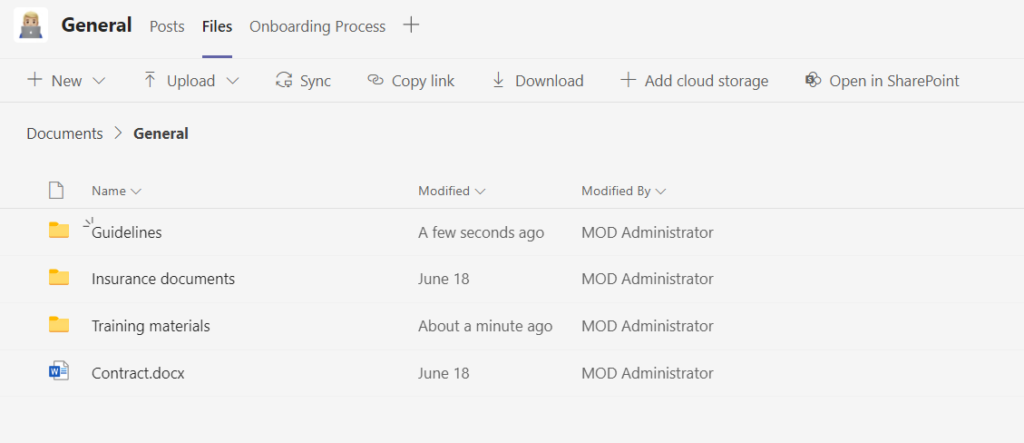
Even when you want to share stuff with them, it’s the same functionality that will help you move on quickly instead of wasting time on back-and-forth emails. Multiple people can edit the same file simultaneously, while chatting about that file specifically in comments or in channel conversations.
You should also consider pinning the most important documents as tabs in relevant channels (e.g., guidelines, budgets, client requirements, etc.) for better visibility.
In addition to the Files, you can also use the Wiki tab. It’s a space where you can add important resources, FAQs, best practices, etc. If you handle a lot of documents on the daily basis then it’ll be helpful to use the Wiki tab for more “permanent” documents (e.g., FAQs, guidelines, etc.) and Files for the rest. This way, it’ll be easier for your team members to locate a file.
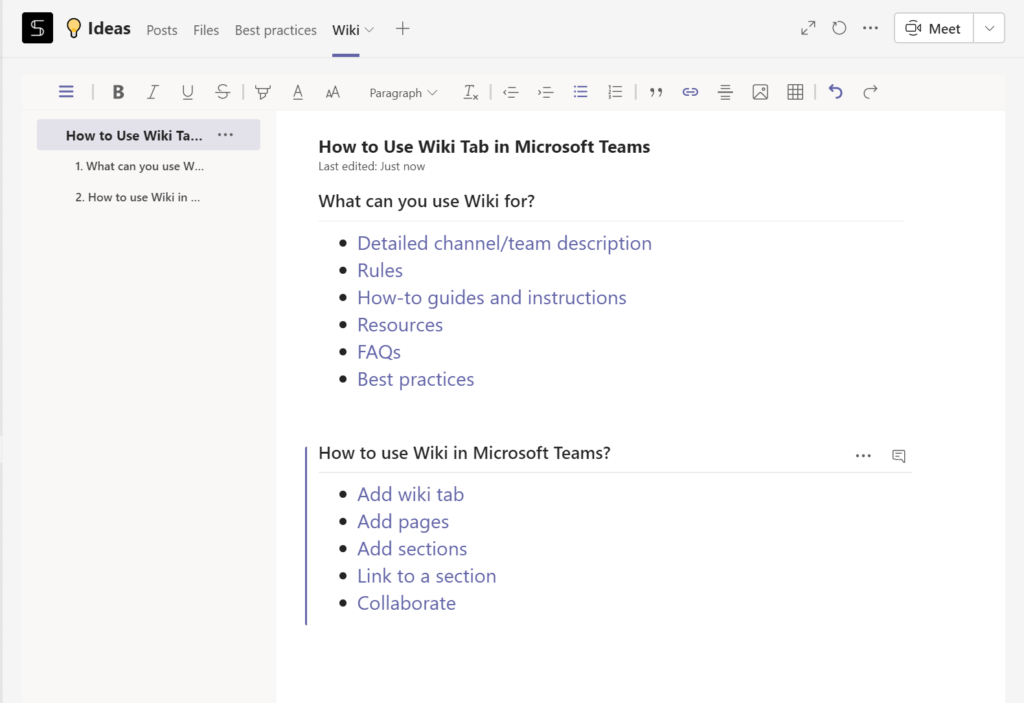
SharePoint handles all data management for Microsoft Teams. It is a cloud-based solution, so it synchronizes your local drive with the cloud using OneDrive. Additionally, it enables real-time updates when you’re online. So security and efficiency are ensured.
Keep the team active
A tested strategy to keep the team active and engaged is by promoting working in the open. It’s when your teams expose the work they’re doing to everyone in the organization. It helps the rest to stay in the loop and if/when needed they can step in to help. In Microsoft Teams, you can do this through channel conversations and a general team where you share company-wide announcements and updates.
Another proven method of engagement is shout outs and praise. Make sure to show your appreciation and acknowledge the work done by employees. In Microsoft Teams, you can do this with the Praise app. It’s an informal yet a very effective way of saying thank you to your teammates.
If you’re looking for more formal ways of praise, make sure to check out this article by Forbes.
And lastly, don’t be scared to have a dedicated “fun” channel for informal conversations in your teams. It has a number of benefits:
- Imitating water cooler conversations,
- Helping maintain the fun and entertainment in the virtual realm,
- The other chats remain for work-related issues only.
After all, at the end of the day, we all appreciate a good meme and a viral TikTok, right?
Must-have apps to manage a team in Microsoft Teams
The last thing we want to share with you are some apps that will come in handy when you manage a team in Microsoft Teams.
Approvals
The Approvals app is a great way to get your team’s official acknowledgment over something. It could be a file, a proposal, a decision, or anything else. You need to send them a request for approval and wait for their confirmation. It could also be the opposite side, and when they want to take a crucial decision, they can get your permission or even a digital signature via the approvals app.
Planner
Add one or more Planner tabs to the channels. It would help you organize tasks, create schedules, to-do lists, and track the status of every project your team is working on. You can set the planners to keep your team aware of the general guidelines of their assigned tasks.
Get teams created with a pre-built set of tasks
Download our Free Guide: How to build Planner with Microsoft Teams Templates
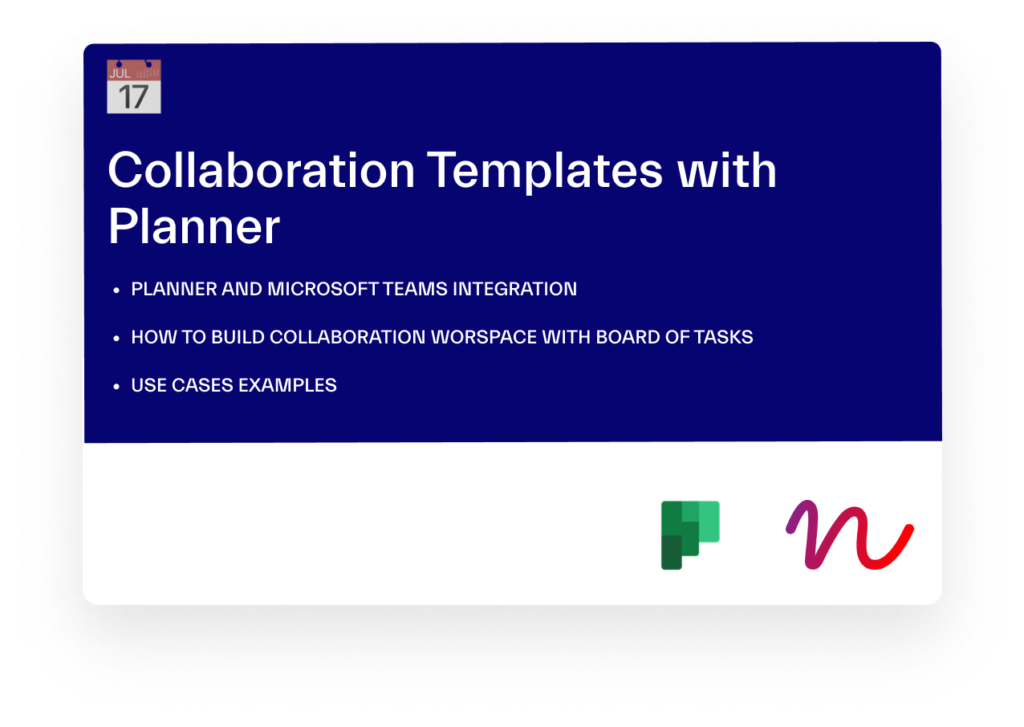
Calendar
Synchronize your calendar with Microsoft Teams. It allows you to keep all records in one place, schedule calls more efficiently, and show others the available time frames to schedule calls with you. Furthermore, you don’t need to worry about being a member of multiple channels because the Calendar app will combine and organize your meetings across all the channels.
Collaboration Templates
If your teams have repetitive processes they work on – projects, campaigns, events, etc., they can create a template using technology like nBold. Collaboration Templates allow to develop predefined structure with the necessary content and tools and people already included right at the template level. So, whenever a new project starts, just use the template to create a new team and start working on it straight away with everything you need already in place.
Management is complex, so you need to take advantage of all the tools that make it even a tad easier. Microsoft Teams offers more than collaboration solutions for team members – it’s the tool you need to manage your team more effectively.

